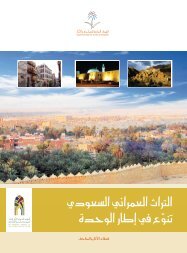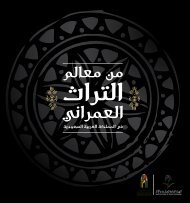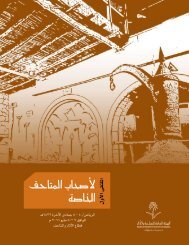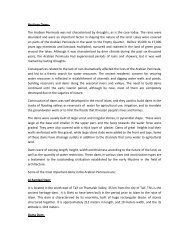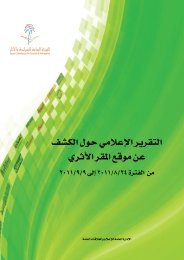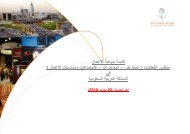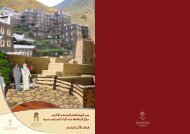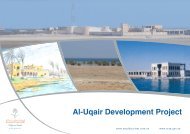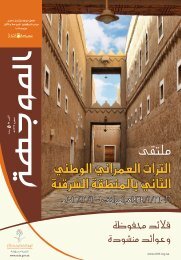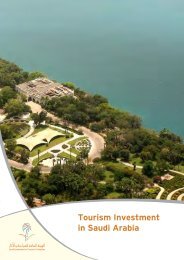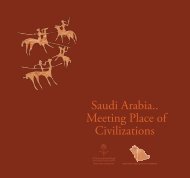Roads of Arabia
Roads of Arabia
Roads of Arabia
You also want an ePaper? Increase the reach of your titles
YUMPU automatically turns print PDFs into web optimized ePapers that Google loves.
25 Arabie US p432-441_BAT.qxd 23/06/10 21:49 Page 436<br />
ROADS OF ARABIA<br />
The Discovery <strong>of</strong> al-Rabadha, a City in the Early Days <strong>of</strong> Islam<br />
dates to the Qarmatians who devastated and ransacked the town, forcing its population to<br />
flee. Thus ended the story, after three centuries <strong>of</strong> prosperity, <strong>of</strong> one <strong>of</strong> the most famous<br />
Muslim cities on the pilgrimage road. The geographer al-Muqaddasi, years after its destruction,<br />
was appalled to discover there nothing but “brackish water and a place <strong>of</strong> desolation”.<br />
Then the pilgrimage road deviated from al-Rabadha. Historians and geographers no<br />
longer mentioned it, as if leaving the task to archaeologists to discover its secrets, traces <strong>of</strong><br />
its constructions and testimonies <strong>of</strong> its urbanization. This is why for centuries and up to<br />
very recently al-Rabadha was known (only by name) and ignored.<br />
The traveller and geographer Muhammad ibn ‘Abdallah ibn Bulayhid (d. 1975) was the<br />
first who sought to draw attention to it and circumscribe its location, but in vain. This failure<br />
pr<strong>of</strong>oundly discouraged scholars. It was only when the author <strong>of</strong> this essay undertook<br />
his doctoral thesis on the vestiges <strong>of</strong> Darb Zubayda that interest in the geographic situation<br />
<strong>of</strong> al-Rabadha was revived. Through examination <strong>of</strong> the historical, geographic and literary<br />
sources related to this route, valuable information was obtained, that proved very helpful on<br />
the first visit to the site, during which the trajectories and cross roads were followed over a<br />
distance <strong>of</strong> more than 1,400 kilometres. This inspection took from May 14 to June 11, 1973.<br />
The data assembled concurred with that <strong>of</strong> the shaykh Hamad al-Jasir who published<br />
an essay in the review al-‘Arab titled: “Al-Rabadha: the location <strong>of</strong> the site”. A certain number<br />
<strong>of</strong> Saudi lexicologists also published useful information on the city in the wake <strong>of</strong><br />
Shaykh al-Jasir, Muhammad ibn Nasir al-‘Abudi, Sa‘d ibn Junaydil and ‘Atiq al-Biladi.<br />
Al-Jasir thus concluded: “In my opinion the site <strong>of</strong> al-Rabadha [he meant the city and not<br />
the protected zone] was located between the Abu Salim basin and the al-Nafazi well; I do<br />
not exclude the fact that this well may be one <strong>of</strong> the many al-Rabadha wells; it could be the<br />
one known in the past under the name Abu Dhar al-Ghifari well and which in the course<br />
<strong>of</strong> time was distorted”. A scientific survey was performed on a section <strong>of</strong> the Darb Zubayda.<br />
It includes archaeological sites in the perimeter where the Abu Salim basin is situated,<br />
appearing under this name on the geographic maps <strong>of</strong> the kingdom <strong>of</strong> Saudi <strong>Arabia</strong>; similarly<br />
the natural sites and the extent <strong>of</strong> the plant covering were circumscribed. This is why<br />
the author <strong>of</strong> this essay was convinced that al-Rabadha was situated in the area containing<br />
the basin and the nearby existing archaeological vestiges.<br />
The investigation clearly revealed that it was east <strong>of</strong> Medina, at almost 200 kilometres,<br />
at the foot <strong>of</strong> the western mountains <strong>of</strong> Hijaz.<br />
Preliminary prospecting <strong>of</strong> the site allowed the team to prepare the excavation <strong>of</strong> this<br />
city while students <strong>of</strong> the archaeology and museology department were trained under the<br />
guidance <strong>of</strong> specialists.<br />
The first excavation campaign took place in May 1979.<br />
These were the grounds for selecting the localization <strong>of</strong> the site <strong>of</strong> al-Rabadha to start<br />
the excavation:<br />
1. The connection <strong>of</strong> the place with the rise <strong>of</strong> Islam and the Prophet’s Companions.<br />
2. The pastoral character <strong>of</strong> the surrounding region and its bonds with the nascent<br />
Islamic state.<br />
3. The gradual development <strong>of</strong> al-Rabadha, which began in the early days <strong>of</strong> Islam and<br />
continued under the Umayyad dynasty until the first Abbasid period, followed by its<br />
destruction and then its disappearance.<br />
4. The historical and geographic sources led to the conclusion that the archaeological<br />
site could <strong>of</strong>fer us useful information about the Islamic civilization; on the one hand, the urban<br />
layout and the architectural piles including houses, numerous industries such as pottery,<br />
ceramic, stone and glass items, and on the other hand, metal utensils, jewellery, inscriptions,<br />
coins and other items produced locally or conveyed from the close or distant capitals<br />
<strong>of</strong> the Islamic Empire.<br />
5. We also hoped that the results <strong>of</strong> the archaeological discoveries would provide us<br />
with coherent pro<strong>of</strong> which might correct the numerous data on early Islamic architecture as<br />
well as on the many forms <strong>of</strong> craftsmanship or ancient scripts, which the rapid changes<br />
affecting the first Islamic capitals such as Bassora, Kufa, Baghdad and Samarra or even al-<br />
Hira (which belonged to the Pre-Islamic period) did not permit us to establish.<br />
6. The archaeological excavations on Islamic sites in Iraq and Syria and resulting interpretations<br />
confronted us with many issues concerning the sources <strong>of</strong> knowledge and characteristics<br />
<strong>of</strong> the Islamic civilization.<br />
Fortunately the results <strong>of</strong> the excavations at al-Rabadha were conclusive. In the twentyfive<br />
campaigns between 1979 and 2003 we were able to gather very significant information<br />
about the urbanism <strong>of</strong> the city, architectural elements, items in ceramic, glass, stone and<br />
metal, coins, scripts, jewellery and decorative elements.<br />
The population <strong>of</strong> the city appears to have settled in a rectangular area going from east<br />
to west. There are no visible ruins <strong>of</strong> the city, save several archaeological mounds <strong>of</strong> which<br />
the layout is not clearly defined. One <strong>of</strong> the site’s most visible vestiges is one <strong>of</strong> the Darb<br />
Zubayda tanks: a circular tank, 65 metres in diameter, 4.70 metres deep, equipped with<br />
a rectangular sedimentation basin measuring 55 x 17 metres and 3.15 metres deep. We<br />
were also able to delimit the cemetery <strong>of</strong> the old city in the south-west part. Its extension<br />
indicates that the city was quite vast and densely populated. During the first campaign the<br />
excavation brought to light three sites which we named A, B and C, to which we added<br />
two others, D and E. Last, we identified a rather large archaeological mound which we<br />
named “401”. During the excavation we unearthed several architectural works comprising<br />
mosques, houses, palaces surrounded by enclosures and thick walls consolidated by circular<br />
Hélène David, 2010<br />
General layout <strong>of</strong> the site<br />
436<br />
437



